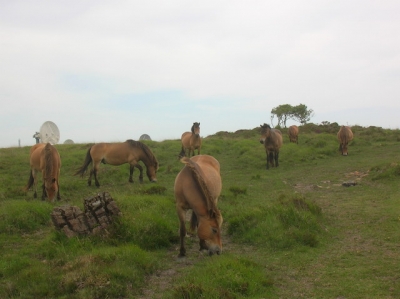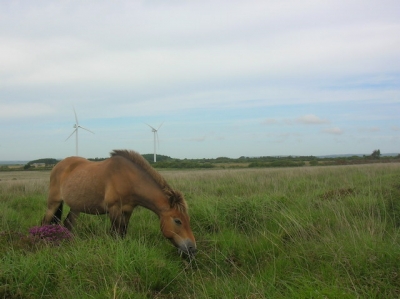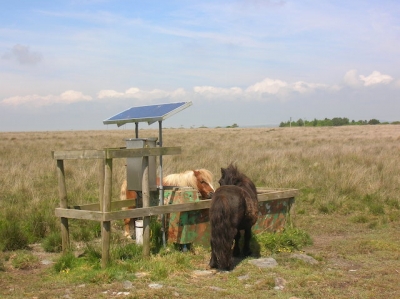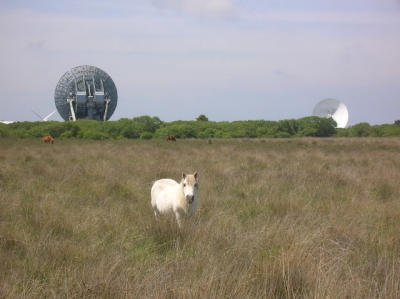 I was at a social gathering several years ago wherein I fell into conversation with a rather grand woman who enquired what I did for a living. When she learned that I was a nature reserve warden she wished to know more of what that exactly involved. I launched into a lengthy talk about the principles of conservation and habitat management, together with a potted history of the Lizard National Nature Reserve. Discovering that she owned a horse, I elaborated on our need to graze the reserve and the vital role played by our own herds of Exmoor and Shetland ponies in achieving this and the importance of putting in the time to ensure that the animal’s welfare was maintained. She considered all this for a few seconds and then remarked “So, you’re basically paid to pat ponies then”, before wandering off to find someone better paid to talk to instead. This illustrated to me that however interesting you may find your job, the finer details may well sail over the heads of most people. Unlikely though it is that the grand lady in question follows ‘Linking the Lizard’, this article will hopefully illustrate that there is more to the management of ponies than a programme of regular patting.
I was at a social gathering several years ago wherein I fell into conversation with a rather grand woman who enquired what I did for a living. When she learned that I was a nature reserve warden she wished to know more of what that exactly involved. I launched into a lengthy talk about the principles of conservation and habitat management, together with a potted history of the Lizard National Nature Reserve. Discovering that she owned a horse, I elaborated on our need to graze the reserve and the vital role played by our own herds of Exmoor and Shetland ponies in achieving this and the importance of putting in the time to ensure that the animal’s welfare was maintained. She considered all this for a few seconds and then remarked “So, you’re basically paid to pat ponies then”, before wandering off to find someone better paid to talk to instead. This illustrated to me that however interesting you may find your job, the finer details may well sail over the heads of most people. Unlikely though it is that the grand lady in question follows ‘Linking the Lizard’, this article will hopefully illustrate that there is more to the management of ponies than a programme of regular patting.
When it comes to managing our herds of both Shetland and Exmoor ponies we endeavour to stick to what are known as the ‘five freedoms’. These are, in no particular order:
• Freedom from Hunger and Thirst
• Freedom from Discomfort
• Freedom from Pain, Injury or Disease
• Freedom to express Normal Behaviour
• Freedom from Fear and Distress
These freedoms ensure, as far as is possible, that all animals have an environment which provides ready access to fresh water, a healthy diet and a degree of shelter, as well as prevention and treatment of ailments, sufficient space and the company of its own kind. When it comes to matters of handling or transportation it ensures that conditions and treatment which avoid mental suffering are the norm.
 A year in the life of an Exmoor pony on the Lizard shows a fairly unwavering degree of consistency. Being Britain’s only true natural pony they are very well suited to the habitats which make up the greater part of Goonhilly Downs. As spring moves on into summer they grow sleek on the wide variety of grasses and herbage that can be found on the heathland and put down reserves that will see them through the harder months to come. The passage from autumn into winter sees the ponies switch to grazing coarser grasses, rushes and sedges and even browsing some gorse and willow.
A year in the life of an Exmoor pony on the Lizard shows a fairly unwavering degree of consistency. Being Britain’s only true natural pony they are very well suited to the habitats which make up the greater part of Goonhilly Downs. As spring moves on into summer they grow sleek on the wide variety of grasses and herbage that can be found on the heathland and put down reserves that will see them through the harder months to come. The passage from autumn into winter sees the ponies switch to grazing coarser grasses, rushes and sedges and even browsing some gorse and willow.
Throughout the year they are checked on a very regular basis by NNR staff and volunteers and, as the harder weather begins to bite, the amount of supplementary feed they receive increases considerably. With two nearby blocks of permanently fenced heathland at their disposal they are moved periodically on foot from one to the other as determined by availability of grazing and time of the year.
 The life of a Shetland pony is an altogether more complex affair and, being cyclical in nature, can be read from any point in the year, but for the purposes of this article we will commence in the springtime. Easter or thereabouts finds all of our Shetland ponies gathered at our workbase at Higher Bochym having recently returned from their winter grazing locations. This twice yearly gathering gives us an opportunity to carry out the necessary checks and tasks that ensure that all our ponies remain in rude health. General condition is assessed and wormer administered to control any burgeoning parasite burden. Most importantly each pony has its hooves checked and trimmed by our local, experienced farrier Mike. The condition of a hoof can tell you much about the state of the animal and indicate any underlying health issues such as laminitis. A well maintained hoof plays a vital role in ensuring the pony remains fit and active for many years to come.
The life of a Shetland pony is an altogether more complex affair and, being cyclical in nature, can be read from any point in the year, but for the purposes of this article we will commence in the springtime. Easter or thereabouts finds all of our Shetland ponies gathered at our workbase at Higher Bochym having recently returned from their winter grazing locations. This twice yearly gathering gives us an opportunity to carry out the necessary checks and tasks that ensure that all our ponies remain in rude health. General condition is assessed and wormer administered to control any burgeoning parasite burden. Most importantly each pony has its hooves checked and trimmed by our local, experienced farrier Mike. The condition of a hoof can tell you much about the state of the animal and indicate any underlying health issues such as laminitis. A well maintained hoof plays a vital role in ensuring the pony remains fit and active for many years to come.
 Having had their springtime MOT, all the ponies take a rest from their endless round of conservation grazing. By now the clifftops are bursting into colour with the appearance of spring flowers whilst the heathlands continue with their winter slumbers for a few weeks longer. Instead the ponies pass the time on the NNR’s back-up grazing paddocks. These areas of grassland lack the floristic richness of much of the land found on the reserve, though the grazing is sufficiently ‘rough’ as to not compromise the general well-being of the stock. Whilst ponies pause, staff continue on their way, planning and preparing for the summer grazing regime. Locations are selected and the necessary fences, gateways and water sources – natural and manmade – are checked and prepared for the imminent arrival of the Shetlands. Warmer weather stirs the heathland into life and with the gradual greening of the site the ponies arrive. This summer the vast majority of the herd will be spending the high days of summer grazing the extensive heathland that makes up northern Goonhilly Downs.
Having had their springtime MOT, all the ponies take a rest from their endless round of conservation grazing. By now the clifftops are bursting into colour with the appearance of spring flowers whilst the heathlands continue with their winter slumbers for a few weeks longer. Instead the ponies pass the time on the NNR’s back-up grazing paddocks. These areas of grassland lack the floristic richness of much of the land found on the reserve, though the grazing is sufficiently ‘rough’ as to not compromise the general well-being of the stock. Whilst ponies pause, staff continue on their way, planning and preparing for the summer grazing regime. Locations are selected and the necessary fences, gateways and water sources – natural and manmade – are checked and prepared for the imminent arrival of the Shetlands. Warmer weather stirs the heathland into life and with the gradual greening of the site the ponies arrive. This summer the vast majority of the herd will be spending the high days of summer grazing the extensive heathland that makes up northern Goonhilly Downs.
The shortening days of early autumn once more finds the ponies all together back at our workbase at Higher Bochym awaiting their second check over of the year. This time there is a far shorter pause in their year and once the necessary checks and preparatory work has been completed the Shetlands are once more on their way – this time to spend the autumn and winter months grazing the coastal grasslands of the Lizard or even further afield. The ponies own response to the onset of wintery conditions can be seen in the thickening of their coats, the equivalent of growing your own fleece and waterproofs. Harsher conditions mean a marked increase in the amount of supplementary feeding they receive and the ponies quickly work out that a member of staff with a yellow bucket in hand means a generous portion of pony nuts will soon be readily available.

Pony grazing on some sites may last the duration of the winter, whilst others will complete their work in the space of a couple of months, with the result that some ponies may be moved to two or three different locations during the season. Rounding up the Shetlands relies on a blend of craft and craftiness – if they are feeling coerced it is highly likely that they won’t play ball. However, using the lay of the land, together with temporary fencing, hurdles and the promise of a bucket of pony nuts, they are soon on their way to pastures new and eventually back to our paddocks at Higher Bochym, where our journey commenced. So there we have it, a tale of how teeth and hooves (and a little human ingenuity) can bring out the full potential of the Lizard NNR and whose main protagonists are more deserving of a round of applause than a pat.
Published: July 2015
Author: Duncan Lyne ( Lizard National Nature Reserve Warden )
